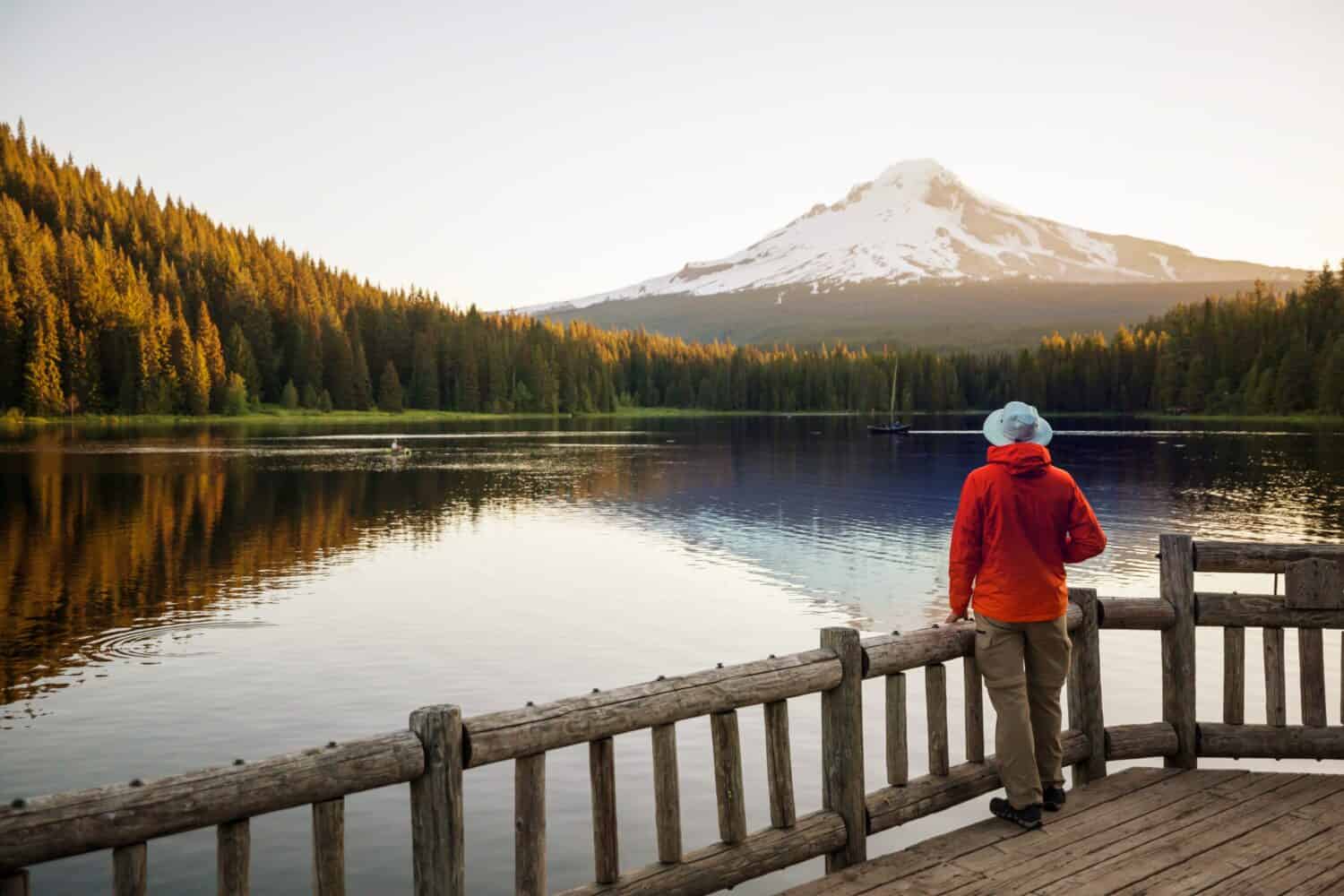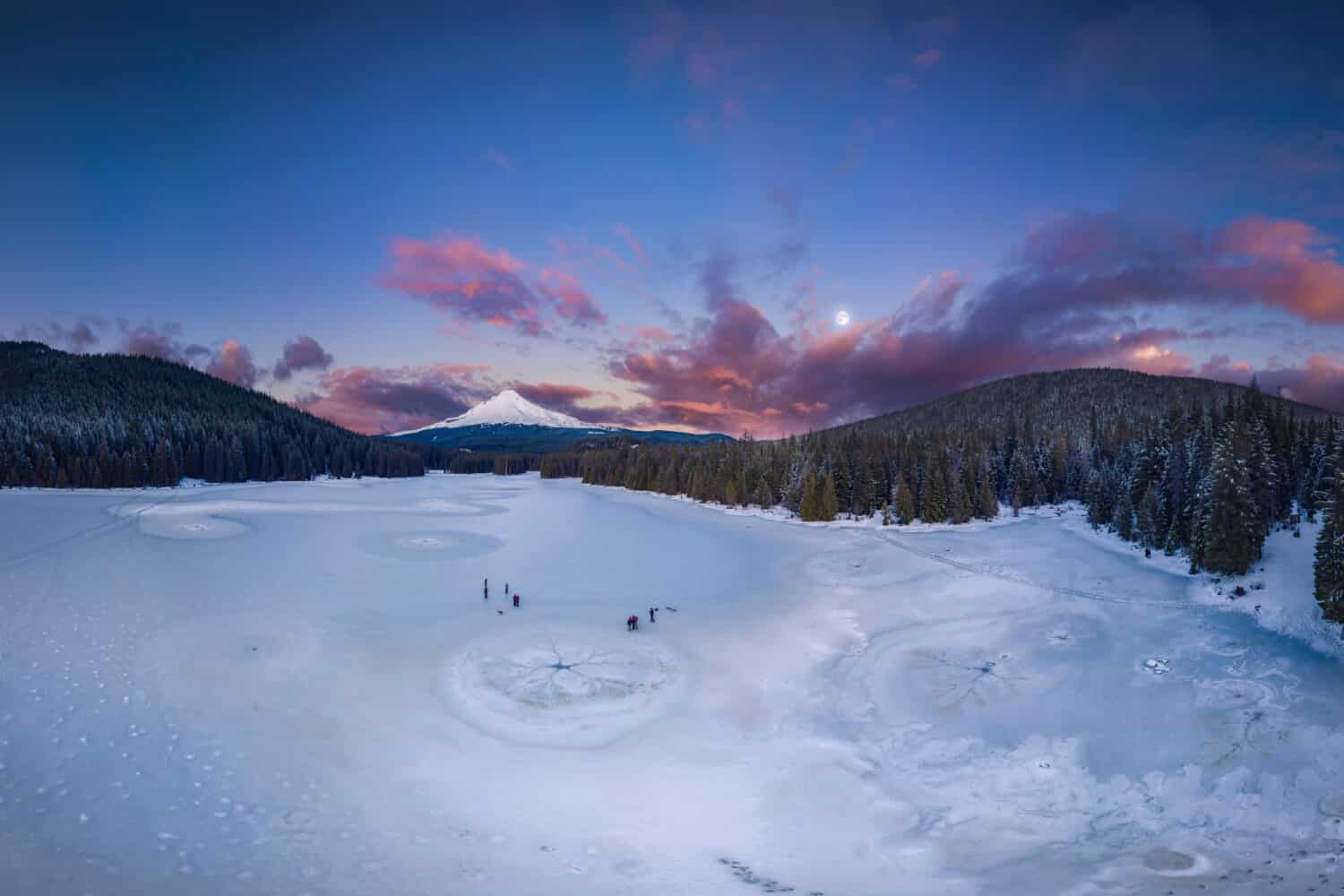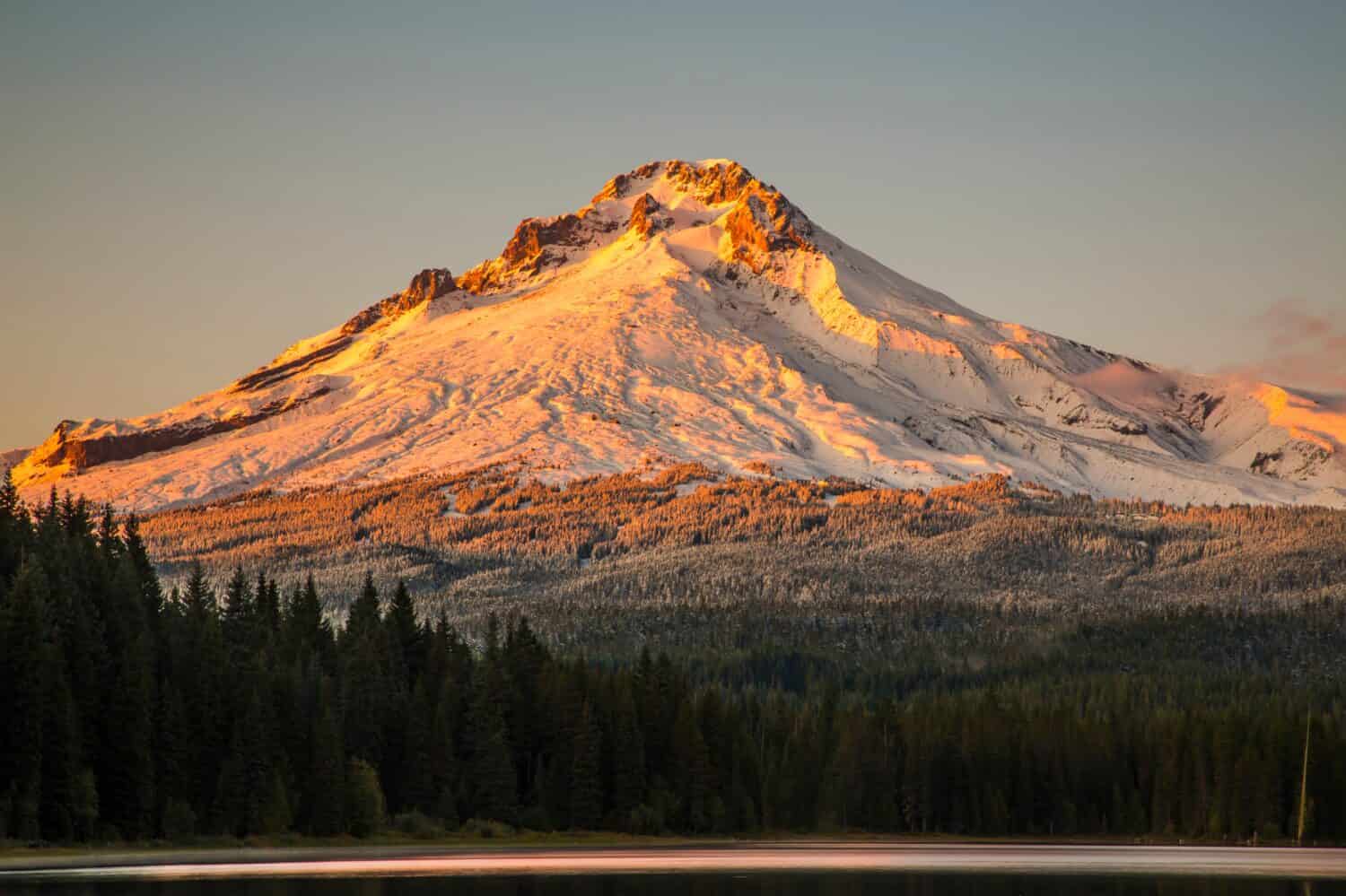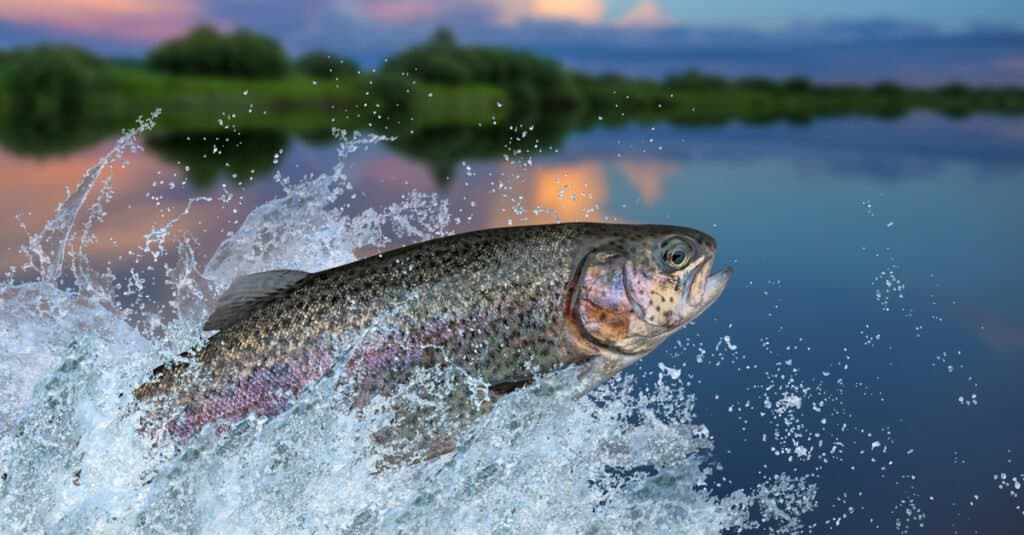Location
Trillium Lake resides in Mount Hood National Forest in Oregon, approximately 60 miles south-southeast of Portland and seven miles southwest of Mount Hood.

Trillium Lake is a destination for artists and nature enthusiasts alike.
©somchaij/Shutterstock.com
History
The history of Trillium Lake in Oregon is as fascinating as the beauty that surrounds it. Before the 1960s, this man-made lake didn’t exist.
For centuries, the region’s indigenous people, including the Wasco, Chinook, and Multnomah tribes, lived in harmony with nature around and within this landscape. They cherished the abundance of natural resources the area provided and held deep cultural and spiritual connections with the land.
The first recorded visit by Europeans to the land of which Trillium Lake resides dates back to the early 1800s when the first immigrants began to traverse the Pacific Northwest. During this time, the Trillium Lake still did not yet exist. The area that now occupies Trillium Lake today was a marshy meadow. The Barlow Road, a component of the Oregon Trail, ran right through it.
As the 20th century unfolded, the surrounding region saw significant changes in land use. In the 1920s and 1930s, the Civilian Conservation Corps (CCC) played a crucial role in developing recreational facilities and maintaining the natural landscape around Trillium Lake. Some of their efforts included fighting fires, building ski areas on Mount Hood, building telephone and electrical wires, and improving farmlands. Their efforts enhanced the area’s appeal and accessibility, drawing more people to the area. Congress terminated the CCC in 1942 following the first world war as they reappropriated the funds and manpower for the war.
From Meadow to Lake
It wasn’t until the 1960s did Trillium Lake come to be. The United States Department of Fish and Wildlife created Trillium Lake by damming at the headwaters of Mud Creek, a tributary to the Salmon River, for recreational purposes.
Today, Trillium Lake is part of the Mount Hood National Forest, managed by the U.S. Forest Service, to preserve its natural beauty and protect the delicate ecosystem. It remains a popular destination for outdoor enthusiasts, offering camping, fishing, hiking, and birdwatching opportunities, amongst many other activities. The lake’s breathtaking scenery continues to captivate the hearts of all who visit, honoring the land’s ancient history and cultural heritage.
The name “Trillium” also holds significance. It refers to a genus of delicate perennial flowering plants native to the area that bloom during the spring. The lake was named after this delightful flowering plant that dots the landscape, adding to the beauty of the location.

Trillium Lake has a surface area of approximately 65 acres.
©TayHamPhotography/Shutterstock.com
Size
In terms of size, Trillium Lake boasts a surface area that spans approximately 65 acres. At its broadest point, the lake’s width reaches around 1,400 feet (430 meters), providing ample space for exploring its shores. Measuring from end to end, the length of Trillium Lake extends about 3,000 feet (910 meters), inviting visitors to wander and take in its breathtaking surrounding landscape.
Trillium Lake’s expansive waters mirror the majestic peak of Mount Hood itself, offering a picture-perfect reflection that enhances its scenic splendor. The lake’s unique combination of size, reflective beauty, and proximity to the iconic mountain creates a harmonious landscape that continues to attract nature lovers, those seeking outdoor recreation, hikers, and artists from far and wide.

Trillium Lake has an ADA-accessible fishing pier.
©Galyna Andrushko/Shutterstock.com
Depth
The depth of Trillium Lake varies across its expanse. The average depth is 7 feet (2.1 meters), while the maximum depth is 21 feet (6.4 meters).
As the seasons shift and temperatures dance to nature’s rhythm, Trillium Lake experiences changes in its waters. In the late summer months, the lake’s surface temperature can rise to 60 to 65 degrees Fahrenheit (15.6 to 18.3 degrees Celsius) at its warmest. This optimal timeframe is the perfect setting for outdoor enthusiasts to enjoy various water activities like swimming, kayaking, canoeing, and fishing in the embrace of nature’s tranquility. Due to its elevation of about 3,600 feet and nearby snowmelt that continues into the summer, Trillium Lake’s waters stay considerably cold throughout summer and into autumn.
When winter blankets the landscape, Trillium Lake dons a frosty coat as temperatures plunge. The chill of the season lowers the water temperature significantly, causing it to dip to near-freezing levels. During the colder months, the lake’s waters can reach a chilly 30 to 36 degrees Fahrenheit (-1.1 to 2.2 degrees Celsius).
And with the arrival of winter’s icy grasp, Trillium Lake is transformed into a stunning winter wonderland. As the air turns frigid, the lake’s surface freezes over. The frozen expanse, adorned with snow, becomes an enchanting sight, attracting visitors seeking winter activities in the mountains.
The seasonal changes in Trillium Lake’s water temperature and its annual freeze-over in winter contribute to its allure as a year-round destination. Whether one seeks to bask in its inviting waters during summer’s warmth or to marvel at its icy enchantment in winter, Trillium Lake offers a myriad of experiences.

Trillium Lake is a man-made lake in Oregon.
©B North Photography/Shutterstock.com
Water Level
The average water level of this charming lake varies, mirroring the ebb and flow of the seasons.
Throughout the year, the water level of Trillium Lake experiences slight fluctuations, responding to the changing patterns of precipitation, snowmelt, and environmental factors. During the rainy season and when the snow atop the majestic Mount Hood begins to melt, the lake’s water level rises, showcasing its expansive glory. In contrast, the water level may recede during the drier months before winter sets in, revealing more of the lake’s charming shores.
The yearly water level trends at Trillium Lake are intriguing to observe. In spring, as nature reawakens, the lake’s water level typically rises, reaching its peak around early summer. This time of abundance coincides with the verdant bloom of flora and fauna, attracting many visitors eager to bask in the lake’s serenity.
As the sun stretches its warmth into the end of summer, the water level gradually declines. By the onset of autumn, the lake gracefully retreats, unveiling hidden landscapes and a few small sandy beaches that had mainly been concealed beneath its waters. This seasonal shift provides unique opportunities for exploration and reflection amidst the lake’s canvas.
With the onset of winter, as snow blankets the region, Trillium Lake freezes over entirely. And come spring, the entire cycle repeats itself. Overall, the fluctuations in Trillium Lake’s water level are a natural consequence of the delicate balance between precipitation, snowmelt, and evaporation.

Ice fishing is a popular winter activity on Trillium Lake.
©Freebilly Photography/Shutterstock.com
Geology
The lake’s origin is a tale etched in the ancient history of volcanic activity and nature’s artistic craftsmanship.
As Trillium Lake didn’t exist before the 1960s, we will refer to the geology of the general area. The landscape was born as a result of a series of geological events that unfolded over hundreds of thousands of years. The story consists mainly of volcanic activity. Mount Hood and its surrounding landscape is composed primarily of andesite and dacite. Mount Hood, a stratovolcano, began to form during volcanic eruptions that took place between 500,000 and 700,000 years ago. During the following millennia, further eruptions continued. This gave shape to the mountain and surrounding terrain.
Today, the lake is nestled within a mixed conifer forest, accentuated by the lush vegetation that encircles its shores.
The geological journey of this landscape, spanning thousands of years, has shaped not only its physical features but also its ecological significance. The surrounding Mount Hood National Forest and its volcanic origins contribute to the rich biodiversity that thrives in and around the lake. This harmonious interplay of geology and nature creates a sanctuary for diverse flora and fauna.

Trillium resides in the shadow of Mount Hood within the Mount Hood National Forest.
©kwan tse/Shutterstock.com
Fishing
Fishing enthusiasts are drawn to the serene waters of Trillium Lake. It offers a diverse and rewarding fishing experience, attracting visitors eager to cast their lines amidst the serene beauty of the landscape.
The most popular fish species found in Trillium Lake include rainbow trout, Skamania trout, brook trout, and lake trout. This makes it a prime location for trout fishing enthusiasts. The shimmering waters provide ample opportunities to catch these elusive fish, known for their spirited fights and vibrant colors.
Types of Fishing
When fishing at Trillium Lake, anglers can indulge in various fishing methods. Casting from the shorelines is a popular choice, allowing anglers to find their ideal fishing spot along the peaceful shores. Additionally, you can fish from boats, providing a unique perspective and access to more secluded fishing areas. Visitors can use non-motorized boats such as canoes and kayaks on the lake, offering a tranquil fishing experience. Other types of fishing include wade, float tube, fly, spin, and bait. In addition, there is also accessible (ADA) fishing available from the fishing pier and boat launch.
Trillium Lake adheres to specific fishing rules and regulations to preserve the ecosystem’s natural balance. Anglers must obtain an Oregon fishing license before casting their lines into the water. It is crucial to familiarize oneself with the fishing regulations the Oregon Department of Fish and Wildlife (ODFW) set forth to ensure compliance with catch limits, size restrictions, and other important guidelines.
Fishing seasons at Trillium Lake vary according to the species. The trout fishing season typically runs from late spring to early fall, coinciding with warmer temperatures and increased fish activity. Winter months offer ice fishing opportunities for anglers as the lake freezes over, providing a unique and chilly fishing experience.
Visitors are encouraged to practice responsible fishing practices, such as catch-and-release, to help sustain the lake’s fish populations for generations. Additionally, anglers are responsible for ensuring they leave no trace and disposing of any waste responsibly to protect the pristine beauty of Trillium Lake and its surroundings.
For those seeking a blissful fishing escapade amidst breathtaking natural splendor, Trillium Lake delivers an unforgettable experience, connecting fishing enthusiasts to the heart of Oregon’s wilderness.

Trillium Lake is a hotspot for trout fishing.
©FedBul/Shutterstock.com
Boating and Other Activities
Trillium Lake, nestled amid the picturesque landscapes of Oregon, beckons adventurers and nature enthusiasts alike with its tranquil waters and stunning surroundings. This lake offers diverse activities that celebrate the changing seasons, making it a year-round paradise for all who venture to this captivating destination.
Boating
Non-motorized boating on Trillium Lake is a cherished activity that allows visitors to immerse themselves in the serene beauty of nature. The lake permits non-motorized watercraft, such as canoes and kayaks, providing a peaceful and eco-friendly boating experience. You can enjoy breathtaking views of Mount Hood’s reflection on the lake’s surface as they glide across the crystal-clear waters, creating a picture-perfect backdrop for memorable adventures.
Swimming
During the balmy summer months, Trillium Lake is a popular place to cool off in its crisp, refreshing waters. Swimming is a popular activity here during the heat of summer, offering a rejuvenating escape from the heat. While swimming, one can relish the surrounding natural beauty.
Hiking and Birdwatching
Surrounding Trillium Lake are verdant trails that wind through the Mount Hood National Forest, offering diverse opportunities for hiking and exploration. Nature lovers can venture into the forest and discover the breathtaking vistas and rich biodiversity it harbors. The Trillium Lake Loop Trail is a 2-mile loop trail around the lake. It is an easy, family-friendly trail. The hike itself takes approximately 35 minutes to complete without stopping.
Birdwatching enthusiasts can spot many avian species that call the forest their home, providing an immersive experience with nature’s avian wonders. Some bird species residing here include the Winter Wren, Golden-crowned Kinglet, Red-breasted Nuthatch, Hermit Thrush, Townsend’s Warbler, and Hermit Warbler.
Winter Activities
When winter blankets the landscape, Trillium Lake transforms into a breathtaking wonderland. As temperatures drop and snow covers the ground, the lake often freezes over, creating a mesmerizing sight. Ice fishing becomes popular during this time, providing a unique and chilly experience for fishing enthusiasts.
The snowy landscapes surrounding Trillium Lake invite adventurers to partake in snowshoeing and cross-country skiing. Gliding through the abundant snow, visitors can revel in the winter magic and connect with nature’s tranquility.
Mount Hood and Mount Hood National Forest
Trillium Lake is closely connected to the iconic Mount Hood, Oregon’s highest peak. The mountain offers mountaineering opportunities for those seeking thrilling ascents. Mount Hood is also adorned with numerous hiking trails, catering to all skill levels and revealing views of the surrounding landscapes.
Additionally, the lake is within proximity to the Mount Hood National Forest, a vast expanse of pristine wilderness offering a wide range of recreational activities, such as mountain biking. The forest’s scenic beauty, combined with the diverse flora and fauna it supports, adds to the attraction of Trillium Lake.
Timberline Lodge
For winter sports enthusiasts, the renowned Timberline Lodge, a National Historic Landmark, on Mount Hood is roughly 10 miles from Trillium Lake. The ski resort offers an array of thrilling slopes for carving through the snow, providing exhilarating experiences amidst the winter landscape. Snow tubing is another highlight of the ski lodge, offering fun and laughter for visitors of all ages. Additionally, the exterior of the Timberline Lodge was used in the cult classic “The Shining.”
Conservation
Visitors are encouraged to practice Leave No Trace to ensure that Trillium Lake’s natural beauty remains intact for generations.
The principles of “Leave No Trace” are guidelines designed to promote responsible outdoor ethics and minimize the impact of human activities on natural environments. These principles aim to ensure that individuals and groups can enjoy nature’s beauty while preserving it for future generations to experience and appreciate. The Leave No Trace Center for Outdoor Ethics, a nonprofit organization, advocates for these principles and educates outdoor enthusiasts on their importance. The seven principles of Leave No Trace are as follows.
1. Plan and Prepare
Before embarking on any outdoor adventure, research and plan your trip thoroughly. Familiarize yourself with the area’s regulations, guidelines, and potential hazards. Consider weather conditions, group size, and the specific needs of the environment you’ll be visiting. Proper planning helps prevent accidents and ensures a more enjoyable and responsible outdoor experience.
2. Travel and Camp on Durable Surfaces
Stick to established trails, campsites, and paths to minimize your impact on delicate ecosystems. Avoid trampling on vegetation or disturbing wildlife habitats. When camping, choose durable surfaces like established campsites, rock, or gravel, and set up at least 200 feet away from water sources to protect them from contamination.
3. Dispose of Waste Properly
Pack out all trash and litter from your outdoor activities. Leave the environment cleaner than you found it. Properly dispose of waste, including food scraps, hygiene products, and litter, to prevent pollution and preserve the natural beauty of the surroundings.
4. Leave What You Find
Respect the natural environment by leaving rocks, plants, and historical or cultural artifacts undisturbed. Avoid picking flowers or removing items from the area. Observing nature without leaving a trace ensures that others can enjoy the same experience in its original state.
5. Minimize Campfire Impact
Where campfires are allowed, use established fire rings or fire pans and keep fires small. Use only dead and downed wood for fires and avoid collecting live vegetation. When possible, use a camp stove for cooking to minimize the impact on the environment.
6. Respect Wildlife
Observe wildlife from a distance and avoid getting too close. Feeding animals can disrupt their natural behavior and be harmful to their health. Keep your distance and do not approach or attempt to touch or feed them.
7. Be Considerate of Other Visitors
Respect other outdoor enthusiasts’ experiences by maintaining a reasonable noise level and allowing them to enjoy the tranquility of nature. Yield to others on the trail, and avoid blocking pathways or causing obstructions. Be mindful of the impact your actions may have on the experience of fellow adventurers.

Non-motorized boating is allowed on Trillium Lake.
©LadyLesBois/Shutterstock.com
Camping
The Trillium Lake Campground offers an enchanting camping experience, allowing campers to immerse themselves in the beauty of nature and create unforgettable memories amid the serene lake.
The campground near the lake’s shores offers a rustic retreat for those seeking an authentic camping experience. The campground features dozens of single and double sites for tent and RV camping. Each site has a picnic table and campfire ring with a grill. This allows campers to enjoy meals and evening gatherings while basking in the tranquil ambiance of the lake. Access to vault toilets and drinking water is available for campers’ comfort. Reservations are available, as well as first-come, first-served sites, and some fully accessible (ADA) sites. There is also an amphitheater and various educational programs during the summer weekends.
Trillium Lake is a sought-after destination for camping during the open season from June through September. From late spring to early fall, camping enthusiasts can revel in the agreeable weather and pleasant conditions, surrounded by lush greenery and the gentle ripple of the lake’s waters.
Planning and making reservations for camping at Trillium Lake is essential, as the campground can be popular and fill up quickly, especially during peak seasons. Properly preparing for the camping trip ensures a smooth and enjoyable experience amidst the wonders of Oregon’s landscapes.

Trillium Lake Campground offers comfortable car camping opportunities.
©anatoliy_gleb/Shutterstock.com
Where is Trillium Lake Located on a Map?
Trillium Lake is situated just southwest of Mt. Hood in the Mt. Hood National Forest. If traveling from Portland, drive east on Highway 26 for about 55 miles. From there, turn right 1 mile east of Government Camp onto Forest Road 2656 (Trillium Lake Road). Then, continue on this road for roughly 2 miles, going past the campground turn-off, continuing to the entrance day-use picnic area or boat launch.
Thank you for reading! Have some feedback for us? Contact the AZ Animals editorial team.







